NF-κB is activated in response to temozolomide in an AKT-dependent manner and confers protection against the growth suppressive effect of the drug
- PMID: 23259744
- PMCID: PMC3551789
- DOI: 10.1186/1479-5876-10-252
NF-κB is activated in response to temozolomide in an AKT-dependent manner and confers protection against the growth suppressive effect of the drug
Abstract
Background: Most DNA-damaging chemotherapeutic agents activate the transcription factor nuclear factor κB (NF-κB). However, NF-κB activation can either protect from or contribute to the growth suppressive effects of the agent. We previously showed that the DNA-methylating drug temozolomide (TMZ) activates AKT, a positive modulator of NF-κB, in a mismatch repair (MMR) system-dependent manner. Here we investigated whether NF-κB is activated by TMZ and whether AKT is involved in this molecular event. We also evaluated the functional consequence of inhibiting NF-κB on tumor cell response to TMZ.
Methods: AKT phosphorylation, NF-κB transcriptional activity, IκB-α degradation, NF-κB2/p52 generation, and RelA and NF-κB2/p52 nuclear translocation were investigated in TMZ-treated MMR-deficient (HCT116, 293TLα-) and/or MMR-proficient (HCT116/3-6, 293TLα+, M10) cells. AKT involvement in TMZ-induced activation of NF-κB was addressed in HCT116/3-6 and M10 cells transiently transfected with AKT1-targeting siRNA or using the isogenic MMR-proficient cell lines pUSE2 and KD12, expressing wild type or kinase-dead mutant AKT1. The effects of inhibiting NF-κB on sensitivity to TMZ were investigated in HCT116/3-6 and M10 cells using the NF-κB inhibitor NEMO-binding domain (NBD) peptide or an anti-RelA siRNA.
Results: TMZ enhanced NF-κB transcriptional activity, activated AKT, induced IκB-α degradation and RelA nuclear translocation in HCT116/3-6 and M10 but not in HCT116 cells. In M10 cells, TMZ promoted NF-κB2/p52 generation and nuclear translocation and enhanced the secretion of IL-8 and MCP-1. TMZ induced RelA nuclear translocation also in 293TLα+ but not in 293TLα- cells. AKT1 silencing inhibited TMZ-induced IκB-α degradation and NF-κB2/p52 generation. Up-regulation of NF-κB transcriptional activity and nuclear translocation of RelA and NF-κB2/p52 in response to TMZ were impaired in KD12 cells. RelA silencing in HCT116/3-6 and M10 cells increased TMZ-induced growth suppression. In M10 cells NBD peptide reduced basal NF-κB activity, abrogated TMZ-induced up-regulation of NF-κB activity and increased sensitivity to TMZ. In HCT116/3-6 cells, the combined treatment with NBD peptide and TMZ produced additive growth inhibitory effects.
Conclusion: NF-κB is activated in response to TMZ in a MMR- and AKT-dependent manner and confers protection against drug-induced cell growth inhibition. Our findings suggest that a clinical benefit could be obtained by combining TMZ with NF-κB inhibitors.
Figures
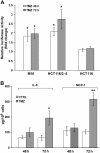


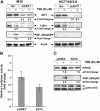
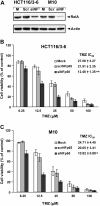
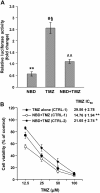
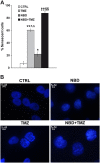
Similar articles
-
AKT is activated in an ataxia-telangiectasia and Rad3-related-dependent manner in response to temozolomide and confers protection against drug-induced cell growth inhibition.Mol Pharmacol. 2008 Jul;74(1):173-83. doi: 10.1124/mol.107.044743. Epub 2008 Apr 15. Mol Pharmacol. 2008. PMID: 18413665
-
Celastrol synergistically enhances temozolomide cytotoxicity in melanoma cells.Mol Cancer Res. 2009 Dec;7(12):1946-53. doi: 10.1158/1541-7786.MCR-09-0243. Epub 2009 Nov 24. Mol Cancer Res. 2009. PMID: 19934274
-
Histone Deacetylase Inhibitor RGFP109 Overcomes Temozolomide Resistance by Blocking NF-κB-Dependent Transcription in Glioblastoma Cell Lines.Neurochem Res. 2016 Dec;41(12):3192-3205. doi: 10.1007/s11064-016-2043-5. Epub 2016 Sep 8. Neurochem Res. 2016. PMID: 27632183
-
How do nuclear factor kappa B (NF-κB)1 and NF-κB2 defects lead to the incidence of clinical and immunological manifestations of inborn errors of immunity?Expert Rev Clin Immunol. 2023 Mar;19(3):329-339. doi: 10.1080/1744666X.2023.2174105. Epub 2023 Feb 9. Expert Rev Clin Immunol. 2023. PMID: 36706462 Review.
-
Use of cell permeable NBD peptides for suppression of inflammation.Ann Rheum Dis. 2006 Nov;65 Suppl 3(Suppl 3):iii75-82. doi: 10.1136/ard.2006.058438. Ann Rheum Dis. 2006. PMID: 17038479 Free PMC article. Review.
Cited by
-
Overexpressed GNA13 induces temozolomide sensitization via down-regulating MGMT and p-RELA in glioma.Am J Transl Res. 2021 Oct 15;13(10):11413-11426. eCollection 2021. Am J Transl Res. 2021. PMID: 34786068 Free PMC article.
-
Sequential treatment of phenethyl isothiocyanate increases sensitivity of Temozolomide resistant glioblastoma cells by decreasing expression of MGMT via NF-κB pathway.Am J Transl Res. 2019 Feb 15;11(2):696-708. eCollection 2019. Am J Transl Res. 2019. Retraction in: Am J Transl Res. 2021 May 15;13(5):5746. PMID: 30899372 Free PMC article. Retracted.
-
Preclinical investigation of ibrutinib, a Bruton's kinase tyrosine (Btk) inhibitor, in suppressing glioma tumorigenesis and stem cell phenotypes.Oncotarget. 2016 Oct 25;7(43):69961-69975. doi: 10.18632/oncotarget.11572. Oncotarget. 2016. PMID: 27564106 Free PMC article.
-
Novel Indications for Bruton's Tyrosine Kinase Inhibitors, beyond Hematological Malignancies.J Clin Med. 2018 Mar 21;7(4):62. doi: 10.3390/jcm7040062. J Clin Med. 2018. PMID: 29561760 Free PMC article. Review.
-
Selective regulation of chemosensitivity in glioblastoma by phosphatidylinositol 3-kinase beta.iScience. 2024 May 7;27(6):109921. doi: 10.1016/j.isci.2024.109921. eCollection 2024 Jun 21. iScience. 2024. PMID: 38812542 Free PMC article.
References
-
- Perkins ND. The diverse and complex roles of NF-kB subunits in cancer. Nat Rev Cancer. 2012;12:121–132. - PubMed
Publication types
MeSH terms
Substances
LinkOut - more resources
Full Text Sources
Molecular Biology Databases
Miscellaneous

